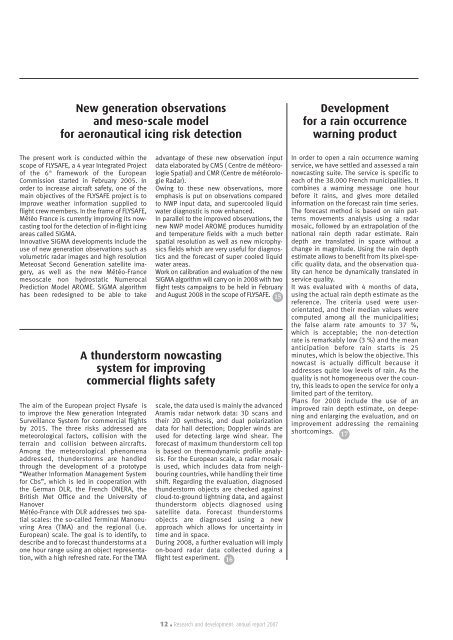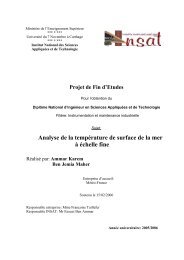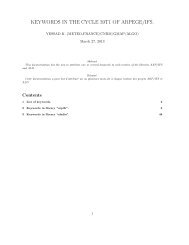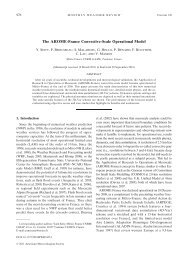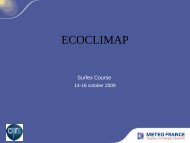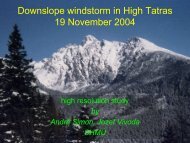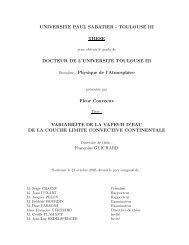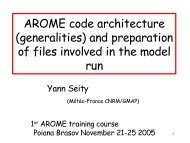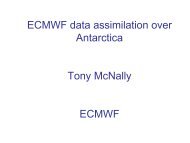3 - Centre National de Recherches Météorologiques - Météo France
3 - Centre National de Recherches Météorologiques - Météo France
3 - Centre National de Recherches Météorologiques - Météo France
You also want an ePaper? Increase the reach of your titles
YUMPU automatically turns print PDFs into web optimized ePapers that Google loves.
New generation observationsand meso-scale mo<strong>de</strong>lfor aeronautical icing risk <strong>de</strong>tectionDevelopmentfor a rain occurrencewarning productThe present work is conducted within thescope of FLYSAFE, a 4 year Integrated Projectof the 6 th framework of the EuropeanCommission started in February 2005. Inor<strong>de</strong>r to increase aircraft safety, one of themain objectives of the FLYSAFE project is toimprove weather information supplied toflight crew members. In the frame of FLYSAFE,Météo <strong>France</strong> is currently improving its nowcastingtool for the <strong>de</strong>tection of in-flight icingareas called SIGMA.Innovative SIGMA <strong>de</strong>velopments inclu<strong>de</strong> theuse of new generation observations such asvolumetric radar images and high resolutionMeteosat Second Generation satellite imagery,as well as the new Météo-<strong>France</strong>mesoscale non hydrostatic NumerocalPrediction Mo<strong>de</strong>l AROME. SIGMA algorithmhas been re<strong>de</strong>signed to be able to takeA thun<strong>de</strong>rstorm nowcastingsystem for improvingcommercial flights safetyThe aim of the European project Flysafe isto improve the New generation IntegratedSurveillance System for commercial flightsby 2015. The three risks addressed aremeteorological factors, collision with theterrain and collision between aircrafts.Among the meteorological phenomenaaddressed, thun<strong>de</strong>rstorms are handledthrough the <strong>de</strong>velopment of a prototype“Weather Information Management Systemfor Cbs”, which is led in cooperation withthe German DLR, the French ONERA, theBritish Met Office and the University ofHanoverMétéo-<strong>France</strong> with DLR addresses two spatialscales: the so-called Terminal ManoeuvringArea (TMA) and the regional (i.e.European) scale. The goal is to i<strong>de</strong>ntify, to<strong>de</strong>scribe and to forecast thun<strong>de</strong>rstorms at aone hour range using an object representation,with a high refreshed rate. For the TMAadvantage of these new observation inputdata elaborated by CMS ( <strong>Centre</strong> <strong>de</strong> météorologieSpatial) and CMR (<strong>Centre</strong> <strong>de</strong> météorologieRadar).Owing to these new observations, moreemphasis is put on observations comparedto NWP input data, and supercooled liquidwater diagnostic is now enhanced.In parallel to the improved observations, thenew NWP mo<strong>de</strong>l AROME produces humidityand temperature fields with a much betterspatial resolution as well as new microphysicsfields which are very useful for diagnosticsand the forecast of super cooled liquidwater areas.Work on calibration and evaluation of the newSIGMA algorithm will carry on in 2008 with twoflight tests campaigns to be held in Februaryand August 2008 in the scope of FLYSAFE. 15scale, the data used is mainly the advancedAramis radar network data: 3D scans andtheir 2D synthesis, and dual polarizationdata for hail <strong>de</strong>tection; Doppler winds areused for <strong>de</strong>tecting large wind shear. Theforecast of maximum thun<strong>de</strong>rstorm cell topis based on thermodynamic profile analysis.For the European scale, a radar mosaicis used, which inclu<strong>de</strong>s data from neighbouringcountries, while handling their timeshift. Regarding the evaluation, diagnosedthun<strong>de</strong>rstorm objects are checked againstcloud-to-ground lightning data, and againstthun<strong>de</strong>rstorm objects diagnosed usingsatellite data. Forecast thun<strong>de</strong>rstormsobjects are diagnosed using a newapproach which allows for uncertainty intime and in space.During 2008, a further evaluation will implyon-board radar data collected during aflight test experiment. 16In or<strong>de</strong>r to open a rain occurrence warningservice, we have settled and assessed a rainnowcasting suite. The service is specific toeach of the 38.000 French municipalities. Itcombines a warning message one hourbefore it rains, and gives more <strong>de</strong>tailedinformation on the forecast rain time series.The forecast method is based on rain patternsmovements analysis using a radarmosaic, followed by an extrapolation of thenational rain <strong>de</strong>pth radar estimate. Rain<strong>de</strong>pth are translated in space without achange in magnitu<strong>de</strong>. Using the rain <strong>de</strong>pthestimate allows to benefit from its pixel-specificquality data, and the observation qualitycan hence be dynamically translated inservice quality.It was evaluated with 4 months of data,using the actual rain <strong>de</strong>pth estimate as thereference. The criteria used were userorientated,and their median values werecomputed among all the municipalities;the false alarm rate amounts to 37 %,which is acceptable; the non-<strong>de</strong>tectionrate is remarkably low (3 %) and the meananticipation before rain starts is 25minutes, which is below the objective. Thisnowcast is actually difficult because itaddresses quite low levels of rain. As thequality is not homogeneous over the country,this leads to open the service for only alimited part of the territory.Plans for 2008 inclu<strong>de</strong> the use of animproved rain <strong>de</strong>pth estimate, on <strong>de</strong>epeningand enlarging the evaluation, and onimprovement addressing the remainingshortcomings. 1712 . Research and <strong>de</strong>velopment: annual report 2007


